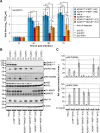Extensive editing of cellular and viral double-stranded RNA structures accounts for innate immunity suppression and the proviral activity of ADAR1p150
- PMID: 30496178
- PMCID: PMC6264153
- DOI: 10.1371/journal.pbio.2006577
Extensive editing of cellular and viral double-stranded RNA structures accounts for innate immunity suppression and the proviral activity of ADAR1p150
Abstract
The interferon (IFN)-mediated innate immune response is the first line of defense against viruses. However, an IFN-stimulated gene, the adenosine deaminase acting on RNA 1 (ADAR1), favors the replication of several viruses. ADAR1 binds double-stranded RNA and converts adenosine to inosine by deamination. This form of editing makes duplex RNA unstable, thereby preventing IFN induction. To better understand how ADAR1 works at the cellular level, we generated cell lines that express exclusively either the IFN-inducible, cytoplasmic isoform ADAR1p150, the constitutively expressed nuclear isoform ADAR1p110, or no isoform. By comparing the transcriptome of these cell lines, we identified more than 150 polymerase II transcripts that are extensively edited, and we attributed most editing events to ADAR1p150. Editing is focused on inverted transposable elements, located mainly within introns and untranslated regions, and predicted to form duplex RNA structures. Editing of these elements occurs also in primary human samples, and there is evidence for cross-species evolutionary conservation of editing patterns in primates and, to a lesser extent, in rodents. Whereas ADAR1p150 rarely edits tightly encapsidated standard measles virus (MeV) genomes, it efficiently edits genomes with inverted repeats accidentally generated by a mutant MeV. We also show that immune activation occurs in fully ADAR1-deficient (ADAR1KO) cells, restricting virus growth, and that complementation of these cells with ADAR1p150 rescues virus growth and suppresses innate immunity activation. Finally, by knocking out either protein kinase R (PKR) or mitochondrial antiviral signaling protein (MAVS)-another protein controlling the response to duplex RNA-in ADAR1KO cells, we show that PKR activation elicits a stronger antiviral response. Thus, ADAR1 prevents innate immunity activation by cellular transcripts that include extensive duplex RNA structures. The trade-off is that viruses take advantage of ADAR1 to elude innate immunity control.
Conflict of interest statement
The authors have declared that no competing interests exist.
Figures








References
-
- Schneider WM, Chevillotte MD, Rice CM. Interferon-stimulated genes: a complex web of host defenses. Annu Rev Immunol. 2014;32:513–45. 10.1146/annurev-immunol-032713-120231 - DOI - PMC - PubMed
-
- Hartner JC, Walkley CR, Lu J, Orkin SH. ADAR1 is essential for the maintenance of hematopoiesis and suppression of interferon signaling. Nat Immunol. 2009;10(1):109–15. 10.1038/ni.1680 - DOI - PMC - PubMed
-
- Bass BL, Weintraub H. An unwinding activity that covalently modifies its double-stranded RNA substrate. Cell. 1988;55(6):1089–98. 10.1016/0092-8674(88)90253-X - DOI - PubMed
-
- Wagner RW, Smith JE, Cooperman BS, Nishikura K. A double-stranded RNA unwinding activity introduces structural alterations by means of adenosine to inosine conversions in mammalian cells and Xenopus eggs. Proc Natl Acad Sci U S A. 1989;86(8):2647–51. 10.1073/pnas.86.8.2647 - DOI - PMC - PubMed
-
- Nishikura K. A-to-I editing of coding and non-coding RNAs by ADARs. Nat Rev Mol Cell Biol. 2016;17(2):83–96. 10.1038/nrm.2015.4 - DOI - PMC - PubMed
Publication types
MeSH terms
Substances
Grants and funding
LinkOut - more resources
Full Text Sources
Other Literature Sources
Molecular Biology Databases
Research Materials
Miscellaneous

